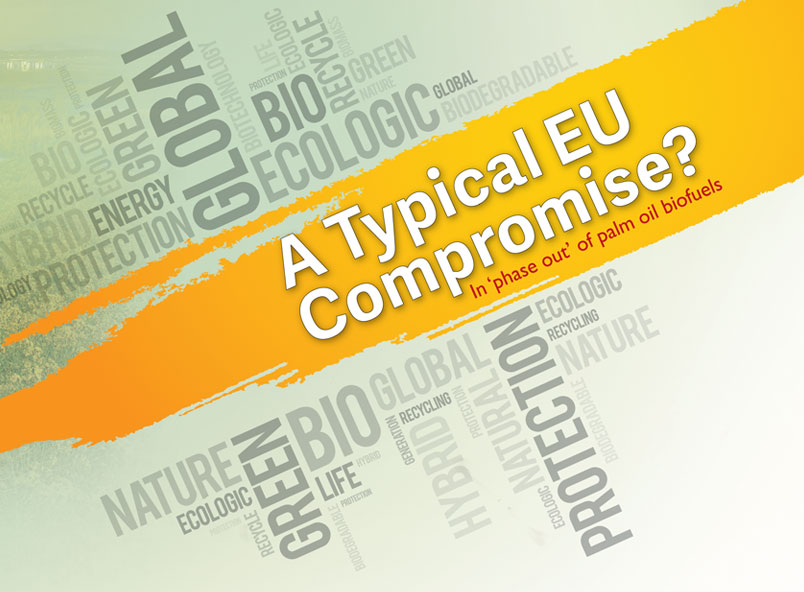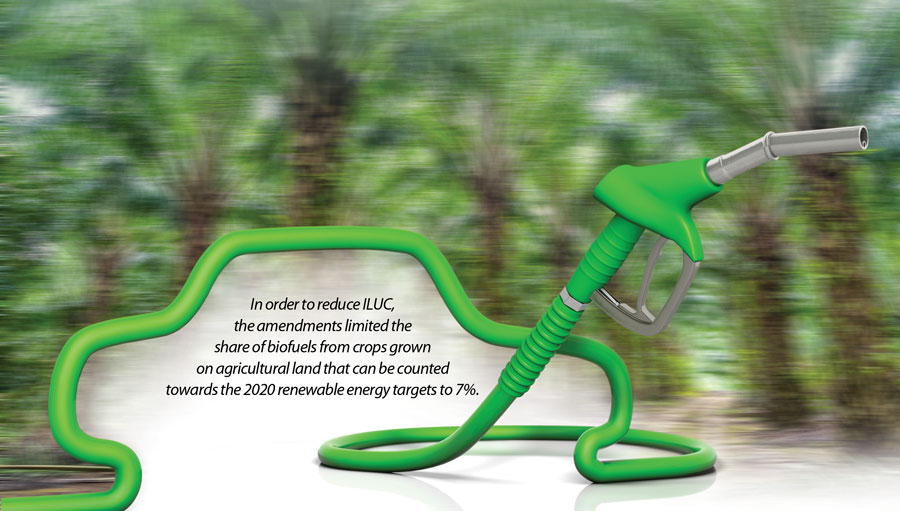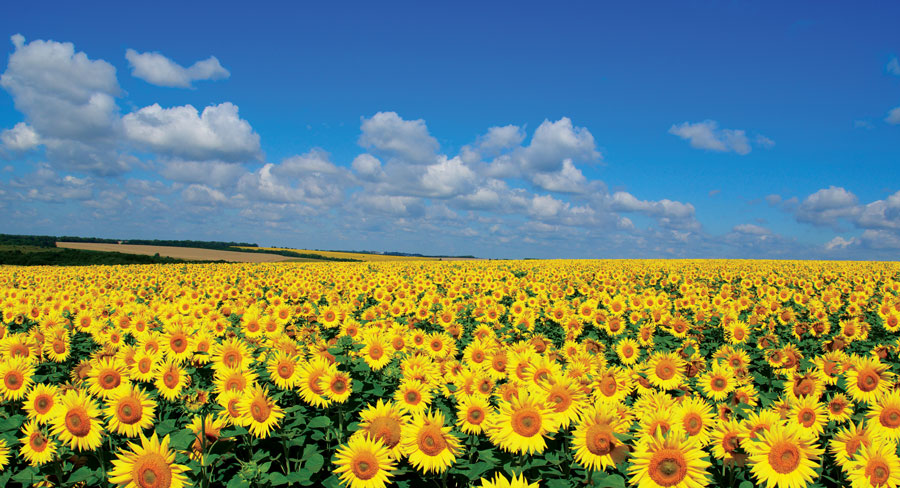



In 'phase out' of palm oil biofuels
October, 2018 in Issue 3 - 2018, Cover Story
On June 14, 2018, the Council of the EU (the Council), the European Parliament and the European Commission (EC) reached a political agreement during the ‘trilogue’ negotiations on the update of the Renewable Energy Directive (RED II).
While the compromise – reached behind closed doors – must be formally approved by the European Parliament and the Council before entering into force, no changes are expected. The agreed text is not yet publicly available, but key aspects have been detailed with the announcement of the compromise.
Contrary to what has been announced by certain involved parties, in particular by Members of the European Parliament (MEPs) and then picked up by the media, the RED II compromise does not yet include an express ‘ban’ on palm oil biofuels. Rather, it hides the ‘ban’ on palm oil biofuels behind rules that will apply to all biofuels crops.
The RED II calls for the determination of ‘low indirect land-use change-risk biofuels’. The use of such biofuels was agreed to be frozen at their 2019 level, with the EC then required to recommend phase-out strategies for the period between 2024 and 2030.
The RED II might still lead to a gradual phase-out of palm oil, if palm oil biofuels are considered (as expected) a high rather than a low indirect land-use change-risk biofuel by the EU. The devil is in the detail and the details are not out yet with respect to the criteria that will be used to define indirect land-use change (ILUC) and the factors that will determine which commodities are to be phased out for biofuels production.
In 2016, the EC had submitted its RED II proposal to the other EU institutions. The Council and the European Parliament adopted their positions in December 2017 and January 2018, respectively. In February 2018, the EU institutions started their ‘trilogue’ negotiations.
In its position, the European Parliament had included a controversial phase-out of biofuels made from palm oil from as early as 2021. This proposed ‘ban’, and all other aspects of the legislation, were discussed during the ‘trilogue’ negotiations between February and June 2018. Considering that an express ‘ban’ on palm oil would clearly be held incompatible with international trade rules, the EC and a number of EU member-states consistently opposed the proposed ban.
At the end, the EU drew up a compromise that allows all involved parties to claim victory, but which leaves businesses wondering about the future rules. The RED II does not contain an express ‘ban’ on palm oil biofuels or any specific biofuel. However, the notion of ‘low indirect land-use change-risk biofuels’, which is yet to be defined, was clearly included with palm oil (and perhaps soybean oil) on the negotiators’ mind. While the EC insists that there is no ‘ban’ on palm oil, MEPs touted the compromise as the end for palm oil and soybean oil biofuels by 2030.
The RED II tasks the EC with drafting the methodology to define ‘low indirect land-use change-risk biofuels’ and their production processes by February 2019. It can be expected that the EC will now begin working on defining the concept of ‘low indirect land-use change-risk biofuels’ and the criteria to calculate it.
ILUC refers to the unintended consequence of releasing more carbon emissions due to land-use change around the world, through the expansion of croplands for biofuels production.
In 2015, the EU had introduced rules to amend relevant legislation on biofuels, including the RED, which aimed at reducing the risk of ILUC and to prepare the transition towards advanced biofuels (biofuels not made from food crops). In order to reduce ILUC, the amendments limited the share of biofuels from crops grown on agricultural land that can be counted towards the 2020 renewable energy targets to 7%.
In 2015, no further requirements were introduced in relation to ILUC, which was only fair considering the controversy over the methodologies used to calculate the respective greenhouse gas emissions.
Such calculations are complex and, historically speaking, should be considered hypocritical. This is in view of the vast areas of land changed within the EU in the past (i.e. land-use changes), which will likely not be factored in by the EC, as well as all the vast areas that, around the world, are destined for economic activities other than biofuels production (e.g. beef or other meat production, dairy farming, industrial expansion). ILUC will now become the deciding factor for market access to the EU, admittedly only with respect to biofuels at first.

Legal on paper, illegal in practice?
While the details of the methodology are yet to be defined by the EC, the direction is clear. It indicates that certain products that do not meet the EU’s new requirements for renewable energy will no longer be eligible to be counted for the renewable energy targets and will, therefore, no longer be viable (i.e. incentivised or de facto subsidised) within the EU Single Market.
A definite legal assessment will only be possible once all details to define ‘low indirect land-use change-risk biofuels’ are known. However, on the basis of what is already known, it is clear what aspects would likely be the ones to be legally scrutinised and possibly challenged.
The challengeable aspects appear to be the very issue of ILUC and the potential discrimination against certain crops. ILUC has been controversial all along, largely due to the lack of an appropriate methodology to determine its undesired effects. The EC will now have to come up with a scientific methodology that can withstand scrutiny under international trade law.
In the context of the applicable international legal obligations, in particular of the World Trade Organisation (WTO), the EU and its member-states are bound to the General Agreement on Tariffs and Trade 1994 (GATT) and the Agreement on Technical Barriers to Trade (TBT Agreement).
Article III:4 of the GATT and Article 2.1 of the TBT Agreement require non-discriminatory treatment between ‘like’ products. Such ‘like’ products could include biofuels derived from a variety of sources, such as palm oil, coconut oil, rapeseed oil and sunflower oil. ‘Like’ products may even include first-generation and second-generation biofuels (i.e. biofuels derived from food crops versus biofuels derived from non-food biomass).
Traditionally, the approach used to determine ‘likeness’ includes the consideration of:
Where Article 2.1 of the TBT Agreement is concerned, the WTO Appellate Body has found that the determination of ‘likeness’ using the traditional factors listed is also a determination of the competitive relationship between the compared products.
When applied to biofuels, it is indeed questionable whether the secondary effects, such as the alleged ILUC and deforestation, are issues that could be considered when assessing ‘likeness’. If this interpretation were to be confirmed, the varying levels of effective market access afforded to different types of first-generation biofuels could be deemed as de facto discriminatory.
WTO rules do provide for a number of exceptions to its non-discrimination rules and principles, including, under certain conditions, for environmental considerations. The EU could invoke Article XX of the GATT, which allows WTO members to adopt measures otherwise inconsistent with WTO law in order to attain certain specific objectives of environmental nature. It is imaginable to expect that the EU could argue that the ILUC distinction in the RED II would be ‘necessary to protect human, animal or plant life or health’ or relate ‘to the conservation of exhaustible natural resources’.
However, in order to benefit from these exceptions, the measure at stake would have to comply with the relevant requirements. These include providing evidence that the measure is necessary to protect human, animal and plant life or health, or that it concerns the conservation of exhaustible natural resources; but most importantly that it is (de facto and de jure) non-discriminatory, as well as the least trade-restrictive choice available from a WTO and trade policy perspective.
On the basis of the available information and considering the statements noting that this will be a phase-out of palm oil and soybean oil, this justification appears hardly available. The scientific criteria to be adopted by the EU to define the ILUC test will be the final turf on which a legal challenge before the WTO may be fought.

Unilateral setting of rules
The biofuels sector is only the latest sector to come under increased EU scrutiny and be subject to stringent laws and regulations related to sustainability. The EU, with its important market, is setting the rules for an increasing number of sectors and products, forcing trading partners around the world to comply and often to implement elaborate and costly schemes to certify the legality and/or sustainability of certain products.
This is understandable and at times even necessary when EU regulators are confronted domestically with demanding consumers and public opinion, as well as non-cooperating or foot-dragging third countries. Sometimes domestic competing industries also fuel these sentiments and add to the trade complexities.
Examples such as the EU’s Forest Law Enforcement, Governance and Trade scheme for timber production and trade, the EU’s framework for Illegal, Unreported and Unregulated Fishing, or the EU’s rules applying to conflict minerals, show the way that biofuels regulation and trade in related commodities, such as palm oil and possibly soybean oil, could be headed.
The key objection to this approach does not concern the legitimate objectives pursued by the EU. Rather, it is the unilateral approach to policies that significantly affect trading partners, and which are global in nature and should be addressed globally/multilaterally.
On the one hand, the EU is negotiating comprehensive trade agreements. On the other hand, and on the basis of complex rules and methodologies that are unilaterally defined, the EU effectively threatens to ‘ban’ important commodities from third countries, such as palm oil and soybean oil.
There is no phase-out of specific biofuels yet, but the soon to be drafted methodology to define ‘low indirect land-use change-risk biofuels’ looks poised to be detrimental for palm oil and possibly soybean oil.
Indeed, domestic reactions to the EU’s compromise have been clear, noting that the revised RED II is clearly targeting certain food crops, in particular oil palm. While palm oil biofuels will still be allowed to be imported into the EU, it will not count towards the renewable energy targets, which would likely render it unmarketable for biofuels production. Indonesia and Malaysia have vowed to work together to address this blatant, though still un-adopted, undefined and ‘disguised’ de facto discrimination.
With the EC to start working on the methodology, this is the last chance to influence this important process and ensure that the legitimate environmental objectives are not pursued by the EU at the expense of other countries’ trade opportunities; the application of the principles of international trade; and in discriminatory fashion. The ‘ban’ on palm oil biofuels has not been averted, it appears only to be postponed.

It appears politically inevitable for the EU to move ahead with such initiative and with defining sustainable and unsustainable products. This should not be done unilaterally, but rather through the definition of an internationally-agreed standard for sustainable palm oil.
As often argued, this is a drive that palm oil producing countries, ideally within the Council of Palm Oil Producing Countries, should be championing and taking forward, if need be in partnership with key export markets such as the EU, the US, China and India. Waiting with the head buried in the sand for the EU to act unilaterally is a gamble that the industry should not take.
FratiniVergano
European Lawyers